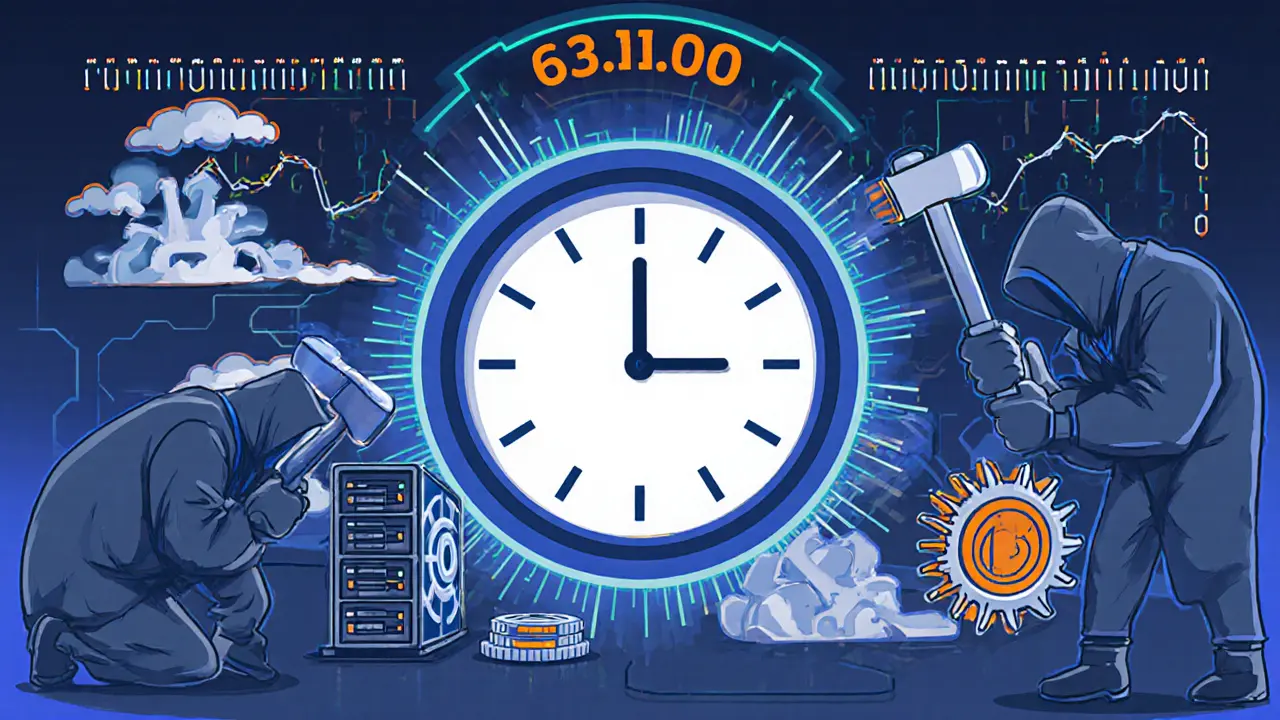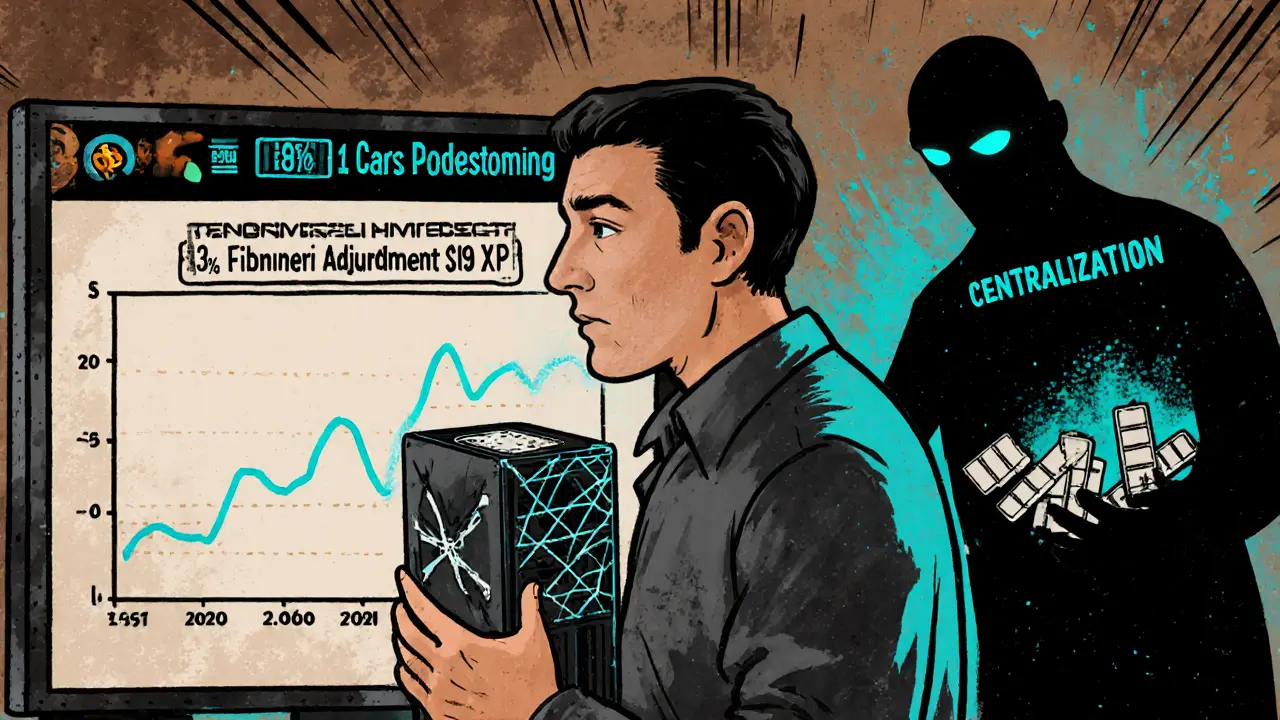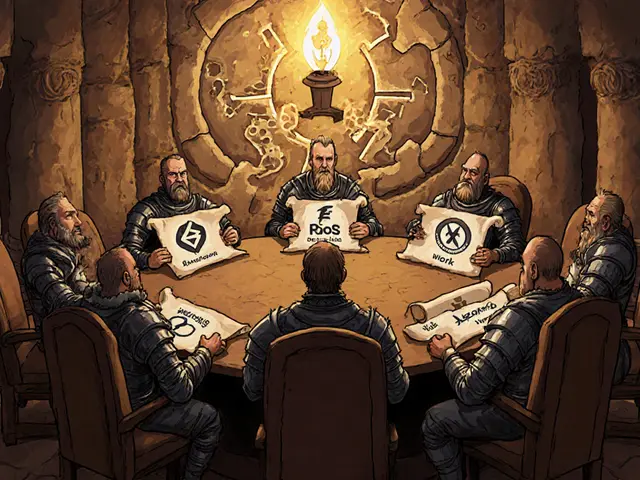Mining Difficulty and Block Time: How Bitcoin Keeps Block Creation Stable

Bitcoin Mining Profitability Calculator
How Bitcoin's Difficulty System Works
Bitcoin adjusts mining difficulty every 2,016 blocks (about two weeks) to maintain approximately 10-minute block times. This calculator helps you understand how difficulty changes impact mining profitability.
Mining Results
The difficulty adjustment formula is: new difficulty = old difficulty × (target time / actual time). Target time is always 20,160 minutes (2,016 blocks × 10 minutes).
Ever wonder why Bitcoin blocks come out roughly every 10 minutes-even when thousands of new miners jump online or entire countries shut down mining operations? The answer isn’t luck. It’s mining difficulty, a self-correcting system built into Bitcoin’s code to keep block time steady no matter how much computing power floods the network.
What Mining Difficulty Actually Does
Mining difficulty is a number that tells miners how hard it is to find a valid hash for a new block. Think of it like a puzzle with a moving target. The lower the target hash value, the harder the puzzle. Bitcoin sets this target so that, on average, a new block is found every 10 minutes. If miners are solving blocks too fast, the network makes the puzzle harder. If they’re too slow, it gets easier.This isn’t manual. It’s automatic. Every 2,016 blocks-roughly every two weeks-Bitcoin checks how long it took to mine those blocks. If the average was 9 minutes per block, difficulty goes up. If it was 11 minutes, it goes down. The formula is simple: new difficulty = old difficulty × (target time / actual time). Target time is always 20,160 minutes (2,016 blocks × 10 minutes). If miners took 18,000 minutes instead, difficulty increases by 12%.
As of October 2023, the difficulty was around 63.35 trillion. That means miners need to try trillions of hash combinations before finding one that meets the target. A valid block hash might need to start with 15 zeros. That’s not something your laptop can do. You need specialized hardware.
Why Block Time Matters More Than You Think
Block time isn’t just a technical detail. It’s the heartbeat of the network. A consistent 10-minute interval gives Bitcoin its balance between security and speed.Too fast? Transactions confirm quicker, but the network becomes more vulnerable to forks. Miners might race to build on the latest block, and if two blocks are found almost simultaneously, the network splits temporarily. That’s risky.
Too slow? Users wait longer for confirmations. Merchants can’t rely on timely settlements. Bitcoin’s 10-minute target was chosen not because it’s perfect, but because it’s stable. It gives enough time for blocks to propagate across the globe before the next one is mined, reducing orphaned blocks and chain splits.
Compare that to Litecoin, which targets 2.5 minutes, or Ethereum Classic at 13 seconds. Those networks prioritize speed but sacrifice some security and decentralization. Bitcoin chose reliability over speed-and it’s held up for over 15 years.

How Difficulty Adjustments Work in Practice
Every 2,016 blocks, the network recalculates difficulty based on the last two weeks of mining activity. But there’s a catch: adjustments can’t swing too wildly. Bitcoin caps increases at 300% and decreases at 75% per adjustment. That prevents sudden, catastrophic swings.Still, big events cause major shifts. When China banned mining in mid-2021, nearly half the network’s hash rate vanished overnight. Difficulty didn’t drop immediately-it kept adjusting upward for weeks because the network hadn’t yet registered the loss. Then, when the adjustment finally hit, difficulty plunged 27.94%. That was the biggest single drop in Bitcoin’s history.
Miners who didn’t see it coming got crushed. Some sold their rigs, thinking difficulty would stay low. Instead, within three months, the network recovered, new miners arrived, and difficulty surged 40%. Those who sold lost tens of thousands of dollars.
This is why professional miners don’t just watch Bitcoin’s price. They track difficulty like a stock chart. Tools like Blockchain.com’s Difficulty Chart, Minerstat’s Forecast, and Bitmain’s analytics dashboards are standard equipment. The best miners use predictive models that factor in new ASIC shipments, electricity costs, and regional regulatory changes.
Miners Are Watching, and So Are Big Companies
It’s not just hobbyists monitoring difficulty. Publicly traded mining companies like Marathon Digital and Riot Blockchain now include difficulty forecasts in their quarterly earnings reports. Why? Because profitability is directly tied to it.Take this real example: In Q3 2023, Bitcoin’s price rose 5%. Sounds great, right? But difficulty jumped 1.35% in the same period. For a miner running a single Antminer S19 XP (140 TH/s), that meant a 3% drop in daily revenue-even though BTC was up. Their electricity bill didn’t change. Their hardware didn’t break. But the puzzle got harder, and their reward shrank.
A 2023 Minerstat survey found that 68% of miners rank difficulty adjustments as their second biggest profitability concern-right after electricity costs. Forty-two percent have shut down operations temporarily after a surprise difficulty spike. That’s not a glitch. That’s the system working as designed.
And it’s getting more complex. The global Bitcoin hash rate hit 600 exahashes per second in October 2023-up from 150 EH/s in early 2021. That’s a 400% increase in computing power. Yet, block time still averages 9.8 minutes. That’s the power of the difficulty algorithm.

What’s Next? New Ideas to Smooth the Ride
Not everyone thinks Bitcoin’s current system is ideal. Dr. David Schwartz of Ripple called the two-week adjustment period outdated. He argues that in today’s world of fast-moving hardware and global mining hubs, waiting two weeks to react is like driving a car with a brake pedal that responds after 10 seconds.That’s why a new proposal called Fibonacci Difficulty Adjustment (BIP-340) is gaining traction. Instead of adjusting difficulty based only on the last 2,016 blocks, it would use a weighted average of the last 10,000 blocks, with more recent blocks carrying more weight. Think of it like a moving average instead of a blunt snapshot.
As of October 2023, 15 of the top 20 mining pools-controlling 68% of the network’s hash rate-have signaled support. If adopted, it could reduce the wild swings miners experience, making profitability more predictable without sacrificing security.
But Bitcoin’s core philosophy is conservatism. Even if the proposal passes, it won’t change overnight. The network moves slowly. That’s intentional. It’s designed to be unbreakable, not flashy.
Why This System Will Last
Gartner’s 2023 Blockchain Infrastructure Outlook predicts Bitcoin’s difficulty mechanism will remain effective through at least 2030. Even with advances in quantum computing, the algorithm doesn’t rely on unbreakable encryption-it relies on computational cost. As long as finding hashes takes energy, and energy costs money, the system holds.The real threat isn’t technology. It’s centralization. As difficulty rises and hardware gets more expensive, only large operators with access to cheap power and bulk equipment can compete. The top 10 mining pools now control over 63% of Bitcoin’s hash rate, up from 52% in 2020. That’s a concern for decentralization-but not for the difficulty algorithm itself. It still works. It just rewards scale.
Bitcoin didn’t need to be perfect. It just needed to be predictable. And for over 15 years, it has been. No matter how many miners join, no matter where they’re located, no matter how much the price swings-blocks still come every 10 minutes. That’s not magic. That’s math. And it’s the reason Bitcoin still works.
How often does Bitcoin’s mining difficulty change?
Bitcoin’s mining difficulty adjusts every 2,016 blocks, which takes about two weeks on average, assuming a 10-minute block time. The network calculates the average time it took to mine those blocks and increases or decreases difficulty to get back to the 10-minute target.
What happens if mining difficulty goes up?
When difficulty increases, miners need more computational power to find a valid block. This reduces profitability unless the price of Bitcoin rises enough to offset the higher energy and hardware costs. Many small miners shut down operations during sharp difficulty spikes because they can’t compete with large-scale farms.
Can mining difficulty go down?
Yes. If miners leave the network-like after China’s 2021 mining ban-the average block time increases. When the next adjustment occurs, difficulty drops to make mining easier again. The largest single drop was 27.94% in July 2021. Difficulty can’t drop more than 75% in one adjustment to prevent the network from becoming too easy to mine.
Do other cryptocurrencies use the same difficulty system?
Many use similar systems, but with different targets. Litecoin adjusts difficulty every 2,016 blocks but targets a 2.5-minute block time. Ethereum Classic adjusts every 100,800 seconds (about 28 hours) for faster response. Bitcoin’s two-week cycle is slower but more stable. Some newer chains use dynamic algorithms that adjust every block, but none have matched Bitcoin’s long-term reliability.
How do miners predict difficulty changes?
Miners use tools like Minerstat, Blockchain.com’s difficulty chart, and CryptoCompare’s calculators to track the current hash rate and estimate future adjustments. The most successful miners combine this data with electricity cost trends, ASIC shipment forecasts, and geopolitical events (like mining bans or energy policy changes) to predict profitability swings.
Is mining still profitable with high difficulty?
It depends. With difficulty at 63+ trillion, profitable mining requires ASIC hardware with 100+ TH/s hash rates and access to electricity under $0.06 per kWh. Most home miners can’t compete anymore. Profitability is now dominated by large operations in Texas, Kazakhstan, and Canada where energy is cheap and regulations are stable. For individuals, cloud mining or buying Bitcoin directly is often more realistic than mining.

